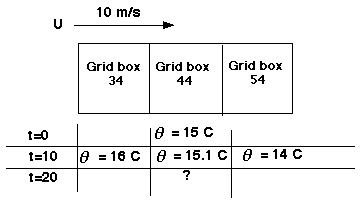New value = old value + change
For example, In this calculator, you have seven input values:
- the potential temperature at the beginning of the forecast (for example, time = 0)
- the potential temperature in the box of interest at some change in time (dt) later, in this example at time = 10 minutes
- the potential temperature in the "western" box at the latest time
- the potential temperature in the "eastern" box at the latest time
- the wind speed (U) in meters/sec (changed to km/min automatically by the calculator)
- the width of the box in the x-direction (dx), in meters
- the time step (dt)
The algorithm for the the cumulative daytime heating is:

For example, a sample scenario (the one modeled by this calculator) is shown below:

In the algorithm above, t= 10 minutes, t+dt= 20 minutes, t-dt = 0 minutes, i=4, k=4.